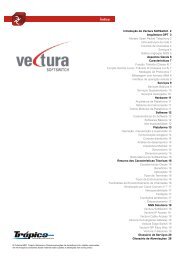Create successful ePaper yourself
Turn your PDF publications into a flip-book with our unique Google optimized e-Paper software.
182 Prolo-Indo-European Morphology4. The AugmentF 213. The augment *(hl)" is common to Greek, Phrygian, Armenian,and Indo-Aryan as an indication <strong>of</strong> the past tense, e.g. PIE *(hl)" bherel =Gr. e-.pepe = Ved. a-bharal. The PIE augment *(hl)" was quite probablyan adverb with the meaning 'at that time' and could be employed facultativelywhere indicative fonus <strong>of</strong> present and aorist stems were combinedwith secondary endings to produce a clear past tense, cf. F 202 § 5. Theestablishment <strong>of</strong> the augment as a norm in the indicative aorist, indicativeimperfect, and indicative pluperfect took place in a post-Proto-IndoEuropean phase. Other IE languages such as Latin or Germanic developedtheir own suffixal means <strong>of</strong> indicating past tense fonus, e.g. Lat.pres. 3 sg. eS-1 'is,' but imperfect 3 sg. er-a-I « *es-ii-I) 'was': MeiserLaul- und Formenlehre 1998 p. 197.K. Brugmann gave the impulse to call the Vedic indicative fonus thatdo not feature an augment 'injunctive.' Vedic features the injunctive as amode <strong>of</strong> its own, with a 'memorative' semantic connotation.Suggestions for further reading: K. Strunk "Der Ursprung des verbalenAugmenles - Ein Problem Franz Bopps aus heuliger Sichf ' inBopp-Symposium 1992 [1994] p. 270-284. - Particularly concerningVedic and its memorative: H<strong>of</strong>finann lnjunktiv 1967. - ConcerningGreek, in which the augment was facultative in poetic language and Mycenaean,but in the Classical language was, as a rule, non-facultative: I.Hajnal in MSS 51 1990 p. 50-55; Meier-Briigger Gr. Sprachw. II 1992 p.50-52; E. J. Bakker "Pointing to the Past: Verbal Augment and TemporalDeixis in Homer" in Euphrosyne, FS Dimilris N Maronitis, Stuttgart1999, p. 50-65. On the New Greek situation see at the end <strong>of</strong> the paragraph.- In Armenian, the augment is only found as a functionless elementin single-syllable verb fonus that permits phonetic reinforcement, e.g.aor. ind. act. 1 sg. beri '1 carried,' but 3 sg. e-ber: J. Wackemagel inWackernagel Kleine Schriften I 1969 (in a contribution from 1906) p.148-155 (Wackemagel refers to the phenomenon <strong>of</strong> the Homeric eoxov'(they) had,' in which *oxov is missing). - Further, compare the characteristics<strong>of</strong> New Greek verbs <strong>of</strong> the type <strong>of</strong>3 sg. Eoeo" 'he has bound' vs.1 pI. MOOIl£ 'we have bound,' in which the augment is preserved when itwas stressed.Verbs 1835. The Verbal AccentF 214. The finite verb <strong>of</strong> an PIE main clause was normally placed followingthe subject and the object, at the end <strong>of</strong> the sentence, where thesentence accent usually decreases. However, when the verb was stressedat the beginning <strong>of</strong> the sentence, or in a subordinate clause, it carried itsnormal accent.1) Researchers agree that Vedic generally reflects the fundamental characteristics<strong>of</strong> Pro to-Indo-European, and thus, that the finite verb in a main clausewas unstressed: Wackemagell Debrunner Ai. Grammalik I 1957 p. 290;Klein Verbal A ccenluation 1992 p. 90; Hettrich Hypotaxe 1988 p. 779.2) It may also be sbown that this assertion about Proto-lndo-European alsoat one time held for Greek. The characteristics <strong>of</strong> Greek may best be understoodif we start from the premise <strong>of</strong> an unstressed finite verb as an establishednorm. Finite verbal forms also featured normal word accents that were used incase the word was in a position <strong>of</strong> emphasis. - The introduction <strong>of</strong> the typicallyGreek restriction <strong>of</strong> all accents to the last three syllables brought a significantchange, forcing all unstressed finite verb forms, which formed accentunity with the preceding word and had generally three or more syllables, to beaccented according to the schema ["- x u], and [x,,- -], cf L 420 § 2. The newaccent was <strong>of</strong>ten used as a word accent, and the old (which <strong>of</strong>ten differed),<strong>of</strong>ten dropped. This explains, among other things, why a verb form such asIlalvoll£v 'we go' carries its accent on the first syllable, although its origin <strong>of</strong>PIE *gwTfI-j6-mes would suggest rather *llatvOIl£V. Only the two-syllableroot presents ellll and $rIlll escaped the effects <strong>of</strong> the radical new accentuation.Not least owing to their shortness, they remained enclitical. For furtherdetails: Meier-Briigger Gr. Sprachw. II 1992 p. 48-50.3) It remains disputed whether the second position <strong>of</strong> the finite verb, common to the modem Germanic languages such as German, originated from theinherited phenomenon <strong>of</strong> enclitics, or whether it appeared secondarily: J.Wackernagel in Wackernagel Kleine Schriflen 1 1969 (in an essay <strong>of</strong> 1892) p.427 ("the german rule <strong>of</strong> word order was already valid in the mother language");Th. Eyth6rsson "Zur HislOrisch-vergleichenden Synlax des Verbumsim Germanischen" in Fachlagung Innsbnlck 1996 [1998) p. 407 note 16:('The hypothesis [is] ... not supported by findings'').





